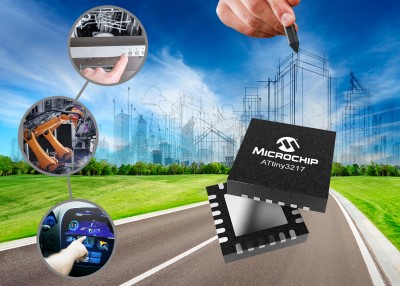Microchip Releases tinyAVR® MCUs With 32kB Memory
Ideal for use as Sensor Nodes with Built-In Peripheral Touch Controller
AVR® microcontrollers (MCUs) have long been used to create highly responsive sensor nodes because of their cost effectiveness and ease of implementation. To enhance the capability and responsiveness of applications in these settings, Microchip has expanded its tinyAVR MCU series to include two new devices with advanced analog features and the largest memory variant in the family. Designed for reliable operation in harsh environments, the devices come with built-in safety functions to help designers create robust and safe systems.

Ideal for sensor applications including capacitive touch interfaces, the ATtiny3217 and ATtiny3216 bring the benefit of two Analog-to-Digital Converters (ADCs) that enable systems to implement touch control simultaneously with other analog measurements. One ADC can be used with the Peripheral Touch Controller (PTC) for touch signal acquisition, while the second one monitors other inputs such as thermistors and pressure sensors, or both ADCs can be used for faster sampling of different types of sensors.
“We continue to invest in bringing new AVR MCUs to the market with advanced features that meet our customers’ needs while easing the development process,” said Steve Drehobl, vice president of Microchip’s MCU8 division. “The combination of responsive touch sensing and built-in safety functions make it easier for designers to improve the user experience in applications such as home appliances, automotive and industrial automation.”
Additional benefits of the ATtiny3217 and ATtiny3216 MCUs include:
- Improved real-time performance and accuracy: The dual ADC can be used for synchronous sampling of analog signals, such as voltage and current, thus improving the overall system real-time performance and accuracy. Additionally, the devices feature a hardware-based Event System that enables inter-peripheral communication without CPU involvement, reducing latency and ensuring faster system response.
- Robust and reliable performance: Both devices come with built-in safety functions to help designers detect and respond to voltage supply variations or drops, including the Power On Reset (POR), programmable Brownout Detect (BOD), Voltage Level Monitor (VLM) and Windowed Watchdog Timer (WWDT).
- Improved noise immunity and functionality in extreme environments: The devices operate at up to 5V and come available in 125°C variants.
- Increased functionality with more room for application code: With 32 KB of Flash, designers have plenty of room for their application code while retaining a small physical footprint on the PCB.
Features of the ATtiny3217 8-bit AVR® Microcontroller
- Core
- AVR® CPU
- Speed up to 20 Mhz
- Two-cycle hardware multiplier
- Memories
- 32 KB Flash Program Memory
- 256 bytes Data EEPROM
- 2 KB Data SRAM
- System
- Watchdog Timer
- Power-On Reset
- Brown-Out Detection
- Single pin programming and debugging interface
- Peripherals
- Two 10-bit ADC with Voltage Reference
- Three 8-bit Digital to Analog Converters
- Analog Comparators
- Configurable Custom Logic
- One 12-bit Timer
- Two 16-bit Timers
- Cyclical Redundancy Check
- Peripheral Touch Controller
- Wake-Up on Touch
- Capacitive touch buttons, sliders, wheels and 2D surfaces
- Up to 14 self capacitance channels
- USART, SPI, and I²C
More information on the ATtiny3216 Microcontroller can be found on the Microchip website at Microchip ATtiny3216 Product Page.
Note: The Microchip name and the Microchip logo are registered trademarks of Microchip Technology Incorporated in the U.S.A and other countries. All other trademarks mentioned herein are the property of their respective companies.
The Microchip website address is www.microchip.com
[Reprinted with kind permission from Microchip Corporation - Release Date, 28th June, 2018]


 About Us
About Us